Consolidated Uranium (CUR) - Focus on Production & Development Assets

Interview with Phillip Williams, President & CEO of Consolidated Uranium (TSX-V: CUR)
Consolidated Uranium Inc. (TSXV: CUR) and (OTCQB: CURUF) is a future uranium producer with assets located in Australia, Canada, Argentina, and the United States. The company’s asset portfolio includes various past-producing mines which may be easily restarted and brought to production.
The company in October 2021, announced that it had concluded with an acquisition agreement as well as a strategic alliance with Energy Fuels Inc. The acquisition agreement consisted of three past-producing and permitted mines in Utah and Colorado, namely the Tony M, Daneros and Rim mines. The strategic agreement the company holds with Energy Fuels Inc. sees the company be the only US uranium company, other than Energy Fuels Inc. with access to the White Mesa Mill, the only permitted and operating conventional uranium mill in the United States.
The company is also investigating the possibility of increasing its footprint in Argentina, with it having sent a team to Argentina recently to investigate further possibilities. Consolidated Uranium Inc. announced in 2022, that it had concluded with the spin-out agreement of Labrador Uranium Inc. The spin-out agreement was conducted through a plan of arrangement which saw Consolidated Uranium Inc. transfer the Moran Lake Project in Labrador Canada to Labrador Uranium Inc. in exchange for 16,000,000 common shares of Labrador Uranium Inc. The company is also currently underway with a 21,000 ft surface drilling program at its US assets to confirm historical mineral resource estimates as well as expand the mineral resources of the mines.

Current Market conditions and the part Consolidated Uranium Inc. aims to play
The fluctuation of the global uranium market over the past year has seen the market be both bullish and bearish. Consolidated Uranium Inc. which implements a diversified project consolidation business model was able to acquire various projects in the market downswing. The upswing of the global uranium market however did not offer the appropriate acquisition environment, with various junior mining companies believing that the market was ideal for advancing projects independently. Philip Williams the president and CEO of Consolidated Uranium Inc. explains that the market is moving towards a less bullish environment increasing the probability of acquisitions, he states:
“…companies have been less interested as the markets have heated up about doing deals with us and I think now they're realising that the consolidation strategy and being part of a bigger entity with better access to capital, better trading liquidity makes a lot of sense. And so those conversations have heated up particularly of late. I think there's a real opportunity for us to continue to pursue that strategy and build our portfolio.”
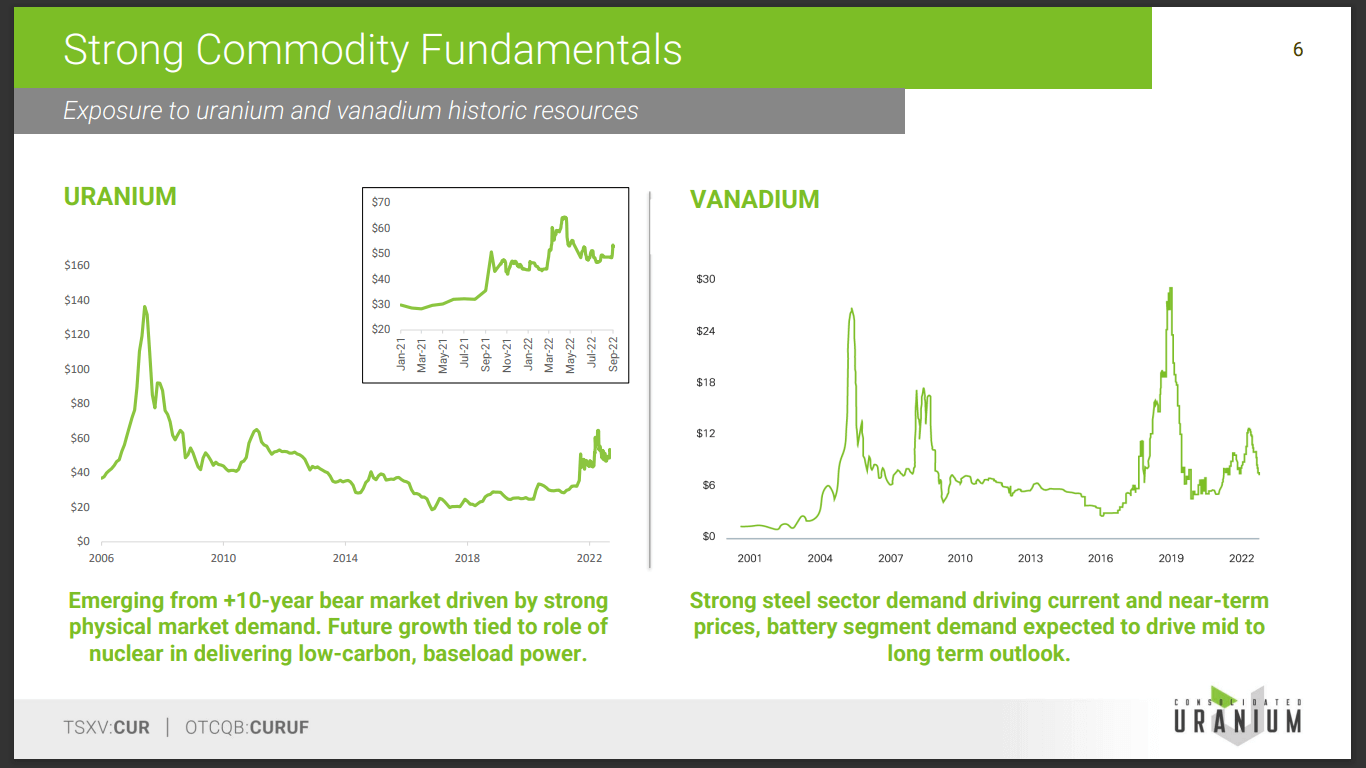
Williams explains that the advantages of a company joining a larger consortium, outweigh the negatives he states:
“…it's a very simple one plus one can equal more than two. That's what we do, we point to the deals that UEC has done, we point to the enCore deal, and we point to the Deep Yellow Vimy deal. Consolidation is happening, there are obvious synergies to doing consolidation in terms of reducing your G&A. But more importantly, it's about what's the growth profile of the combined business. How do we get on more radar screens? How do we lower our cost of capital by having access to bigger institutional investors who want to invest in those bigger companies? And I think together, particularly with some of the assets that we're looking at and companies that we're looking at could be much, much stronger.”
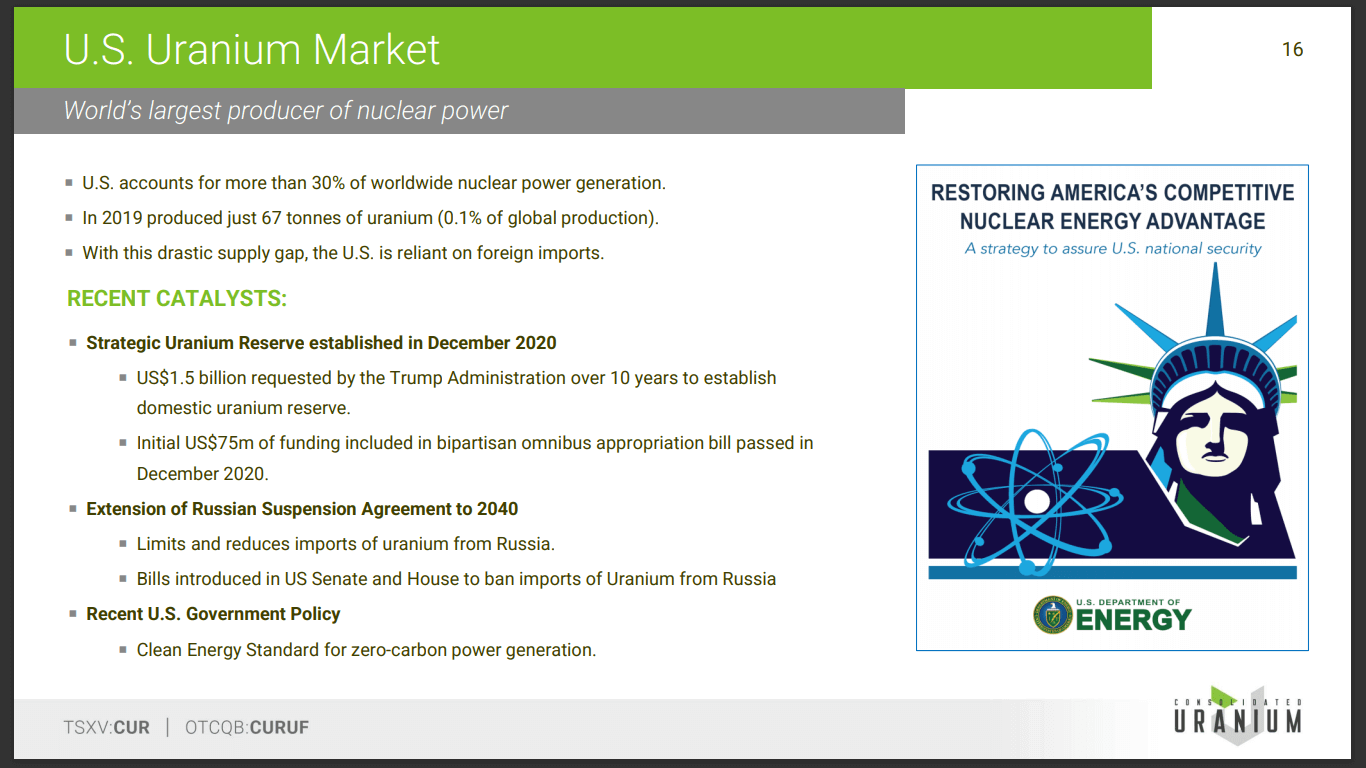
The goal of Consolidated Uranium Inc. is to become a multi-asset uranium producer, with it believing that the first assets of it to reach production will be its US assets. The United States is the world’s largest generator of nuclear power and by extension the largest consumer of uranium globally. Williams explains the company’s goal as follows:
“…our goal here is to create a multi-asset production vehicle which starts in the US, we have past producing mines, we can turn them on very quickly. Now it's about what comes behind that, what jurisdictions we want to go after and what projects you want to add there.”
Williams further adds:
“…we're now pivoting, 100% focused on becoming a producer from our assets in the US. And then it's about, okay, how do we leverage the platform, so we build out this expertise in production. We want to have assets behind that, actually our development assets.”
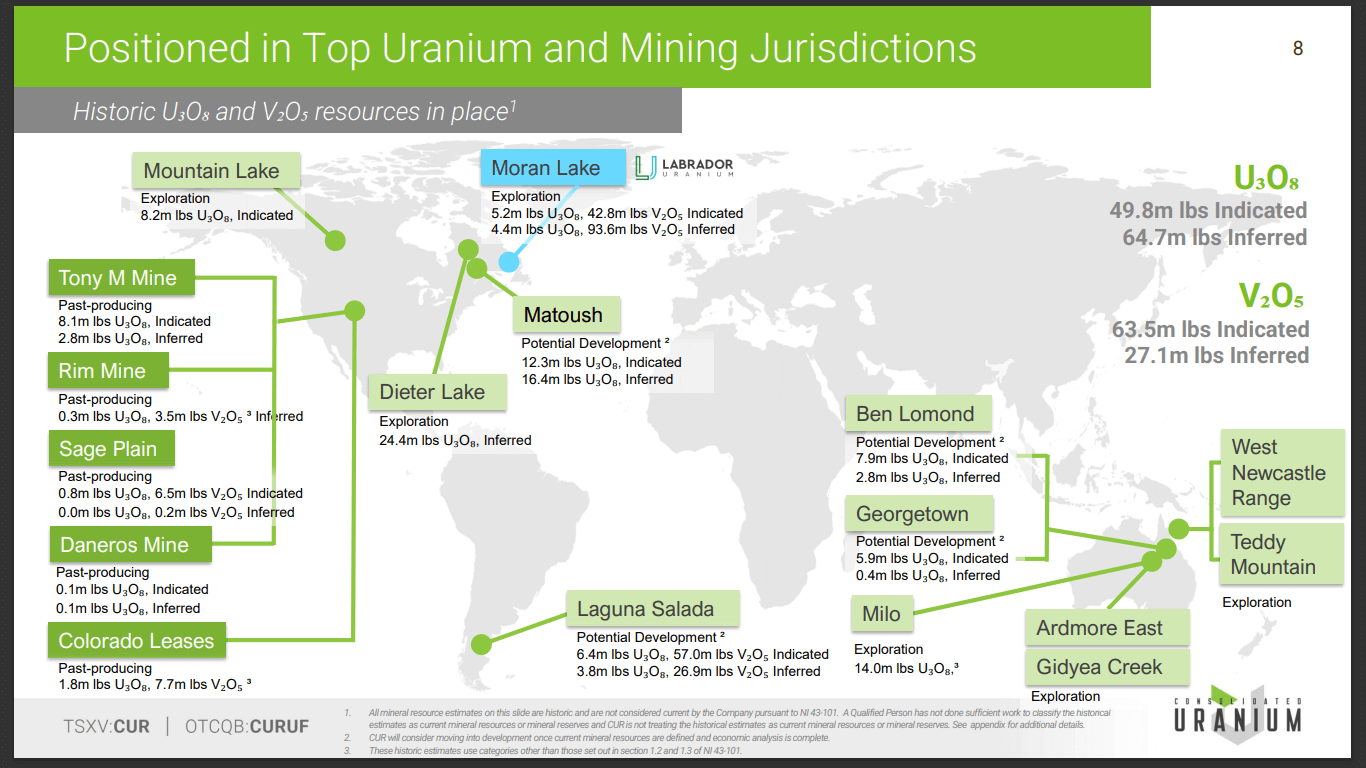
The company is also investigating the possibility to increase its footprint in Argentina, with it having sent a team to Argentina to investigate further possibilities, Williams States:
“…we had the PDAC here in Toronto a couple of weeks ago, there were 9 governors of states in Argentina that had come up to the conference, talking to investors, talking to companies and trying to explain why Argentina is a great jurisdiction for mining investment. We just had a team of four guys go down to Argentina looking at other opportunities, I think that's going to be a very important jurisdiction going forward for us.”
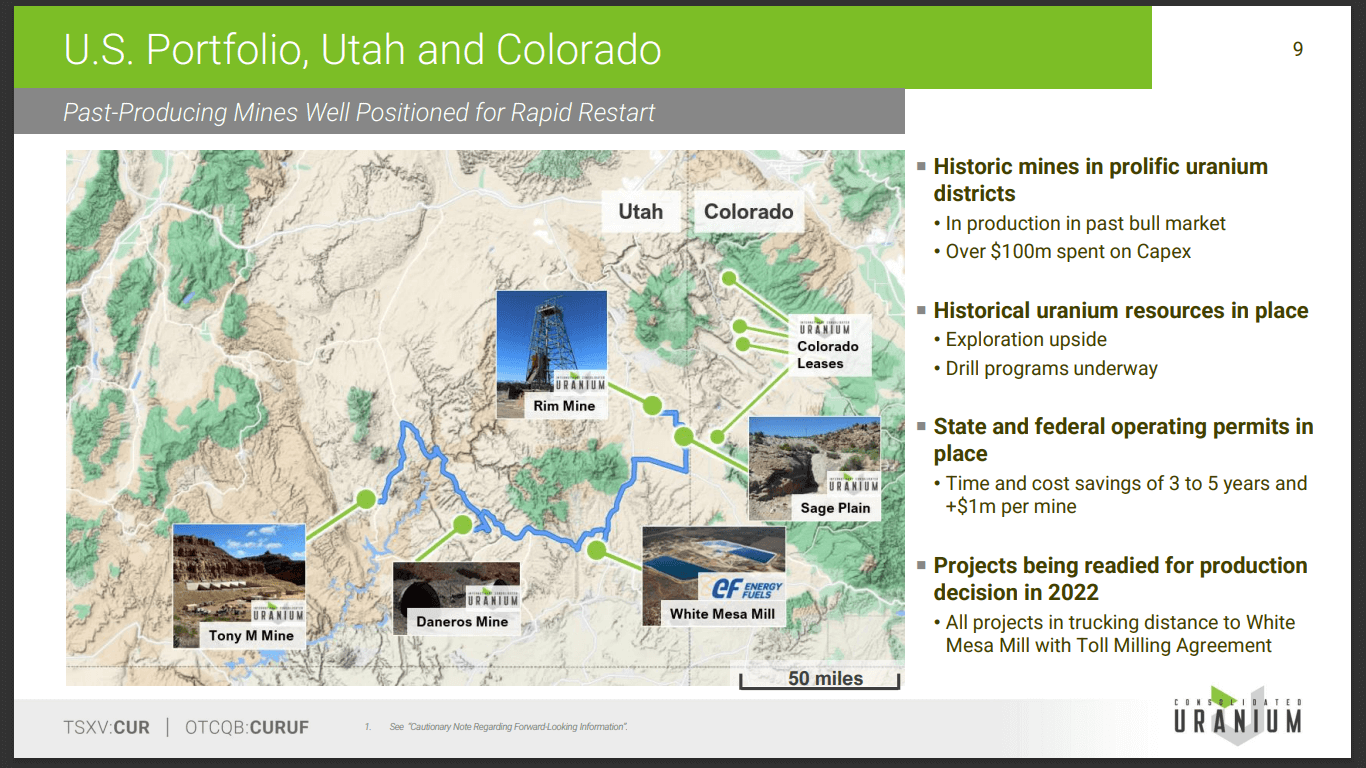
Energy Fuels Inc. agreement and strategic alliance
Consolidated Uranium Inc. announced at the end of 2021, that it had concluded an acquisition agreement with Energy Fuels Inc. for the acquisition of its US assets. The company further entered into a strategic alliance with Energy Fuels Inc. for the usage of the White Mesa Mill, the only permitted and functional conventional uranium mill in the United States.
The acquisition agreement included the Tony M, Daneros and Rim Mines. The Tony M Mine is located in the Henry Mountains area of south-eastern Utah. The mine is a past-producing, large-scale and permitted underground uranium mine that most recently operated in 2008. The Daneros mine is a fully permitted and developed underground uranium mine that was most recently in production in 2013 and is located in Utah. The Rim Mine is located in the East Canyon portion of the Uravan Mineral Belt and is a fully permitted and developed underground uranium mine that was in production until 2009. Williams explains the assets as follows:
“…we couldn't be more excited with those assets and I think this is a great time to be talking about them. Because even when we acquired them, we were still understanding what we had. Over the last 6-months, we've really figured that out and what we've decided to do as part of understanding is to go do work on these projects. We're one of the busier US uranium developers, near-term producers, right now with 3 drill programmes going on, on the 3 past producing mines that we bought from Energy Fuels Inc.”
The strategic agreement with Energy Fuels Inc. consists of a toll milling agreement which will see the company become the only permitted and operating conventional uranium mill in the United States, Williams explains the agreement as follows:
“…we have a USD$ 12 million agreement, which means that we take our order to mill, we pay for our share of the processing cost and we get all the upside when we sell the uranium. We're not sharing any of that with Energy Fuels Inc. I don't want to speak necessarily for Energy Fuels Inc. but I think that they could be looking at or buying agreements with other parties where basically, they just buy the ore and the company might make a small margin, but they don't get the exposure to the Uranium price that we get.”
Williams explains that the agreement sees Consolidated Uranium Inc. having full exposure to the price of uranium, with it not sharing the profit with Energy Fuels Inc. he states:
“Our company is built on leveraging the price of uranium, and I think our investor base is backing us for that reason. If the Uranium price goes on a run, as it did in, 06 and 07, we can get full exposure to that. I think some of our peers will not be able to get that full exposure…”

Labrador Uranium spin-out agreement
Consolidated Uranium Inc. announced in 2022, that it had concluded with the spin-out agreement of Labrador Uranium Inc. The spin-out agreement was conducted through a plan of arrangement which saw Consolidated Uranium Inc. transfer the Moran Lake project in Labrador Canada to Labrador Uranium Inc. in exchange for 16,000,000 common shares of Labrador Uranium Inc. The company will also assume the obligations of the original option agreement for the project which includes future payments to the vendor which are contingent upon the attainment of certain milestones as well as the royalty agreement between Consolidated Uranium Inc. and the Vendor. The royalty agreement entails the payment of a 1.5% net smelter returns (NSR) royalty on the sale of the mineral products extracted or derived from the Moran Lake project.
Williams explains that the strategy of Consolidated Uranium Inc. is to become a producer, with Labrador Uranium Inc. purposely built to be an exploration company, he states:
“Our strategy is to become a producer and a developer of resources, not be an exploration company. And we've never picked up a project that didn't already have resources because that's not our strategy. Exploration is what Labrador Uranium Inc. is purposely built to do.”
The plan of arrangement also included each shareholder of Consolidated Uranium Inc. receiving 0.215 shares of Labrador Uranium Inc. for each share of Consolidated Uranium Inc. held.
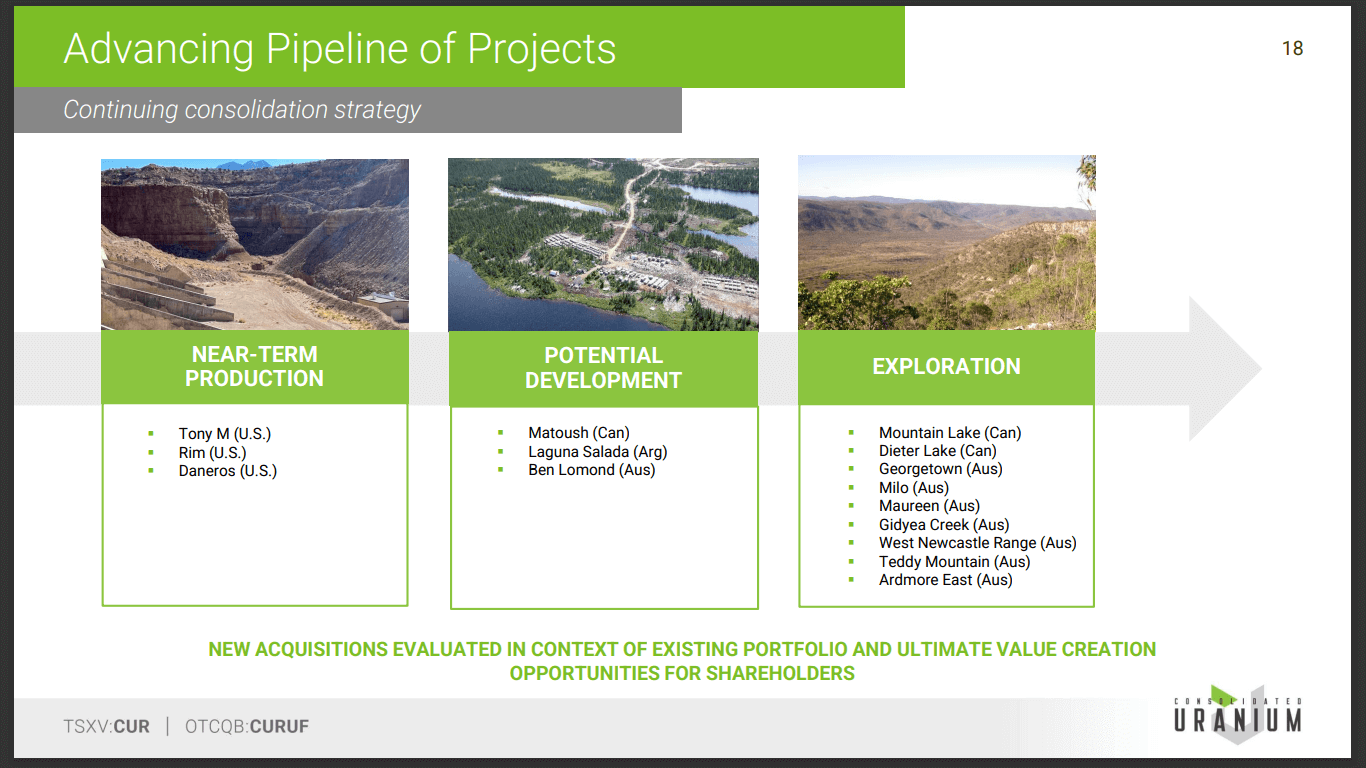
Current exploration activities
Consolidated Uranium Inc. announced at the end of May that it had commenced with a drilling program at its US uranium assets, the Tony M, Daneros and Rim mines. The 21,000 ft surface drilling will be aimed at confirming historical mineral resource estimates as well as expanding the mineral resources of the mines. The drilling program will consist of 6,000 ft of drilling at the Tony M mine, 7,200 ft of drilling at the Daneros mine, which will commence immediately after the conclusion of the drilling program at the Tony M mine and then finally 10,000 ft of drilling at the Rim mine. Williams sums up the company’s exploration initiatives and intent as follows:
“We're going to have an updated 43-101 there at Daneros and Rim, we're conducting exploration drilling there. Those projects haven't been explored beyond where they stopped mining in a decade, so those programmes are going to expand those resources. Then at the same time, we're building our team, we're activating permits, we're going out for contracts for contract miners and we're getting ready to make a production decision towards the end of the year.”
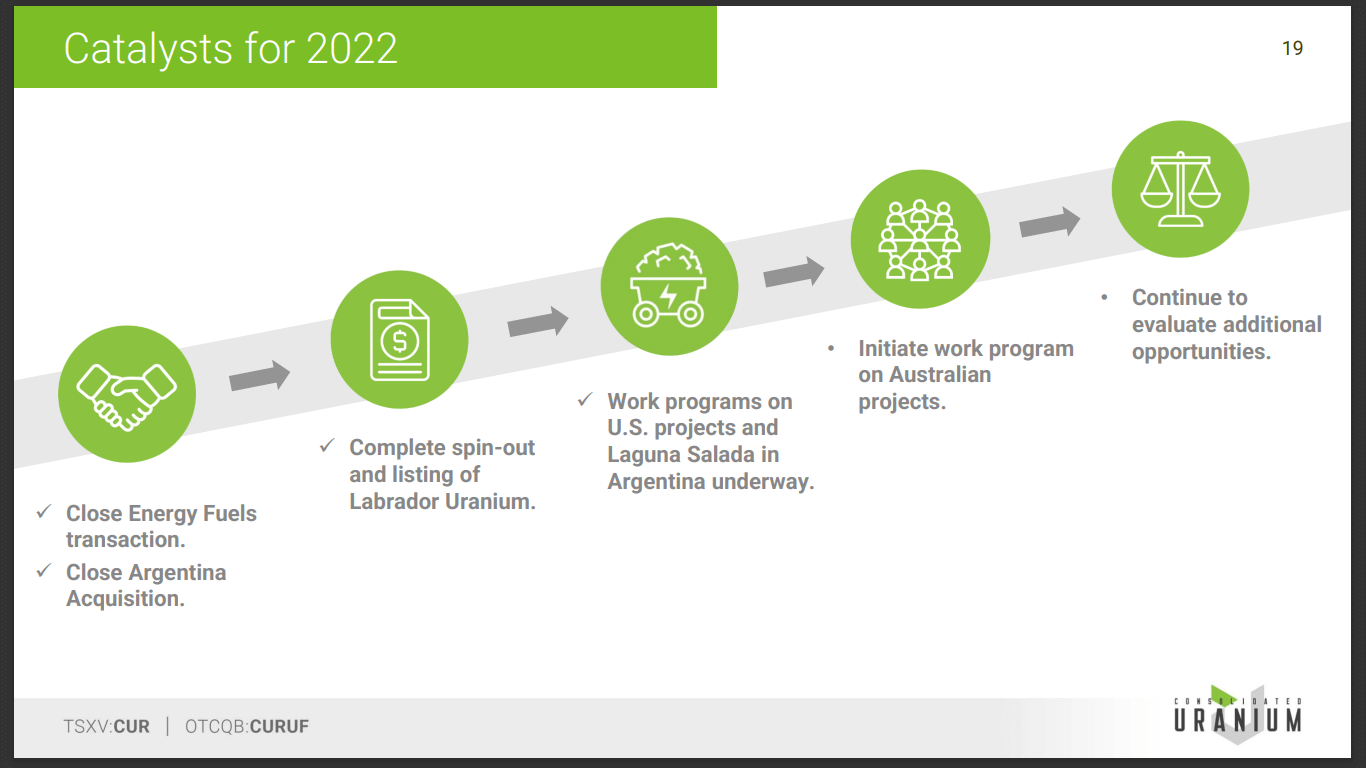
Future
Consolidated Uranium Inc. will be focused on undertaking supply agreements with US utility companies. The company will aim to use its strategic alliance with Energy Fuels Inc. to obtain this goal, with Williams explaining the company’s intent as follows:
“The last piece is the contracts and that's the next piece that we have to tackle and we're working on that. Fortunately, we've got Energy Fuels Inc. as a partner, I mean, they're already signing contracts, and there's every opportunity for us to dovetail in behind them, if that's the path we choose, or go out and try to sign contracts on our own. We're starting to do the work to understand what kind of contracts we could be getting.”
Williams also explains that the company is well positioned to restart its mining operations should it undertake any supply agreement with a US utility, he states:
“…what we're doing is being ready, so that we can make that production decision and go back to production very quickly. I think, again, to hammer home the points about our company and why we're unique in that we can turn on very quickly, fully permitted past-producing mines, we can turn them on very quickly for a low amount of capital and we have access to the mill.”
To find out more, go to the Consolidated Uranium website
Analyst's Notes




Subscribe to Our Channel
Stay Informed












































